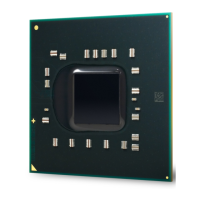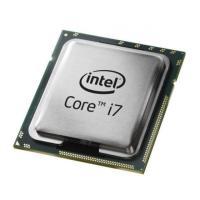Thermal Specifications and Design Considerations
76 Datasheet
5.1.2 Thermal Metrology
The maximum and minimum case temperatures (T
C
) for the processor is specified in
Table 26. This temperature specification is meant to help ensure proper operation of
the processor. Figure 18 illustrates where Intel recommends T
C
thermal measurements
should be made. For detailed guidelines on temperature measurement methodology,
refer to the appropriate Thermal and Mechanical Design Guidelines (see Section 1.2).
5.2 Processor Thermal Features
5.2.1 Thermal Monitor
The Thermal Monitor feature helps control the processor temperature by activating the
thermal control circuit (TCC) when the processor silicon reaches its maximum operating
temperature. The TCC reduces processor power consumption by modulating (starting
and stopping) the internal processor core clocks. The Thermal Monitor feature must
be enabled for the processor to be operating within specifications. The
temperature at which Thermal Monitor activates the thermal control circuit is not user
configurable and is not software visible. Bus traffic is snooped in the normal manner,
and interrupt requests are latched (and serviced during the time that the clocks are on)
while the TCC is active.
When the Thermal Monitor feature is enabled, and a high temperature situation exists
(i.e., TCC is active), the clocks will be modulated by alternately turning the clocks off
and on at a duty cycle specific to the processor (typically 30–50%). Clocks often will
not be off for more than 3.0 microseconds when the TCC is active. Cycle times are
processor speed dependent and will decrease as processor core frequencies increase. A
small amount of hysteresis has been included to prevent rapid active/inactive
transitions of the TCC when the processor temperature is near its maximum operating
temperature. Once the temperature has dropped below the maximum operating
temperature, and the hysteresis timer has expired, the TCC goes inactive and clock
modulation ceases.
With a properly designed and characterized thermal solution, it is anticipated that the
TCC would only be activated for very short periods of time when running the most
power intensive applications. The processor performance impact due to these brief
periods of TCC activation is expected to be so minor that it would be immeasurable. An
Figure 18. Case Temperature (T
C
) Measurement Location
37.5 mm
Measure T
C
at this point
(geometric center o f the package)
37.5 mm
37.5 mm
Measure T
C
at this point
(geometric center o f the package)
37.5 mm

